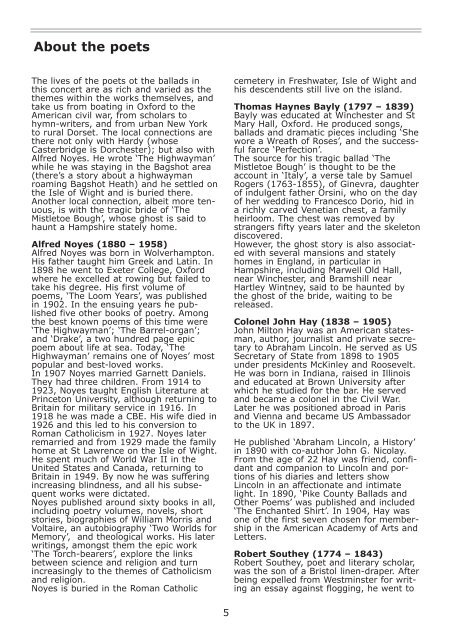HWM programme - Counterparts.org.uk
HWM programme - Counterparts.org.uk
HWM programme - Counterparts.org.uk
You also want an ePaper? Increase the reach of your titles
YUMPU automatically turns print PDFs into web optimized ePapers that Google loves.
about the poets<br />
The lives of the poets ot the ballads in<br />
this concert are as rich and varied as the<br />
themes within the works themselves, and<br />
take us from boating in Oxford to the<br />
American civil war, from scholars to<br />
hymn-writers, and from urban New York<br />
to rural Dorset. The local connections are<br />
there not only with Hardy (whose<br />
Casterbridge is Dorchester); but also with<br />
Alfred Noyes. He wrote ‘The Highwayman’<br />
while he was staying in the Bagshot area<br />
(there’s a story about a highwayman<br />
roaming Bagshot Heath) and he settled on<br />
the Isle of Wight and is buried there.<br />
Another local connection, albeit more tenuous,<br />
is with the tragic bride of ‘The<br />
Mistletoe Bough’, whose ghost is said to<br />
haunt a Hampshire stately home.<br />
alfred noyes (1880 – 1958)<br />
Alfred Noyes was born in Wolverhampton.<br />
His father taught him Greek and Latin. In<br />
1898 he went to Exeter College, Oxford<br />
where he excelled at rowing but failed to<br />
take his degree. His first volume of<br />
poems, ‘The Loom Years’, was published<br />
in 1902. In the ensuing years he published<br />
five other books of poetry. Among<br />
the best known poems of this time were<br />
‘The Highwayman’; ‘The Barrel-<strong>org</strong>an’;<br />
and ‘Drake’, a two hundred page epic<br />
poem about life at sea. Today, ‘The<br />
Highwayman’ remains one of Noyes’ most<br />
popular and best-loved works.<br />
In 1907 Noyes married Garnett Daniels.<br />
They had three children. From 1914 to<br />
1923, Noyes taught English Literature at<br />
Princeton University, although returning to<br />
Britain for military service in 1916. In<br />
1918 he was made a CBE. His wife died in<br />
1926 and this led to his conversion to<br />
Roman Catholicism in 1927. Noyes later<br />
remarried and from 1929 made the family<br />
home at St Lawrence on the Isle of Wight.<br />
He spent much of World War II in the<br />
United States and Canada, returning to<br />
Britain in 1949. By now he was suffering<br />
increasing blindness, and all his subsequent<br />
works were dictated.<br />
Noyes published around sixty books in all,<br />
including poetry volumes, novels, short<br />
stories, biographies of William Morris and<br />
Voltaire, an autobiography ‘Two Worlds for<br />
Memory’, and theological works. His later<br />
writings, amongst them the epic work<br />
‘The Torch-bearers’, explore the links<br />
between science and religion and turn<br />
increasingly to the themes of Catholicism<br />
and religion.<br />
Noyes is buried in the Roman Catholic<br />
5<br />
cemetery in Freshwater, Isle of Wight and<br />
his descendents still live on the island.<br />
Thomas haynes Bayly (1797 – 1839)<br />
Bayly was educated at Winchester and St<br />
Mary Hall, Oxford. He produced songs,<br />
ballads and dramatic pieces including ‘She<br />
wore a Wreath of Roses’, and the successful<br />
farce ‘Perfection’.<br />
The source for his tragic ballad ‘The<br />
Mistletoe Bough’ is thought to be the<br />
account in ‘Italy’, a verse tale by Samuel<br />
Rogers (1763-1855), of Ginevra, daughter<br />
of indulgent father Orsini, who on the day<br />
of her wedding to Francesco Dorio, hid in<br />
a richly carved Venetian chest, a family<br />
heirloom. The chest was removed by<br />
strangers fifty years later and the skeleton<br />
discovered.<br />
However, the ghost story is also associated<br />
with several mansions and stately<br />
homes in England, in particular in<br />
Hampshire, including Marwell Old Hall,<br />
near Winchester, and Bramshill near<br />
Hartley Wintney, said to be haunted by<br />
the ghost of the bride, waiting to be<br />
released.<br />
Colonel John hay (1838 – 1905)<br />
John Milton Hay was an American statesman,<br />
author, journalist and private secretary<br />
to Abraham Lincoln. He served as US<br />
Secretary of State from 1898 to 1905<br />
under presidents McKinley and Roosevelt.<br />
He was born in Indiana, raised in Illinois<br />
and educated at Brown University after<br />
which he studied for the bar. He served<br />
and became a colonel in the Civil War.<br />
Later he was positioned abroad in Paris<br />
and Vienna and became US Ambassador<br />
to the UK in 1897.<br />
He published ‘Abraham Lincoln, a History’<br />
in 1890 with co-author John G. Nicolay.<br />
From the age of 22 Hay was friend, confidant<br />
and companion to Lincoln and portions<br />
of his diaries and letters show<br />
Lincoln in an affectionate and intimate<br />
light. In 1890, ‘Pike County Ballads and<br />
Other Poems’ was published and included<br />
‘The Enchanted Shirt’. In 1904, Hay was<br />
one of the first seven chosen for membership<br />
in the American Academy of Arts and<br />
Letters.<br />
robert Southey (1774 – 1843)<br />
Robert Southey, poet and literary scholar,<br />
was the son of a Bristol linen-draper. After<br />
being expelled from Westminster for writing<br />
an essay against flogging, he went to


